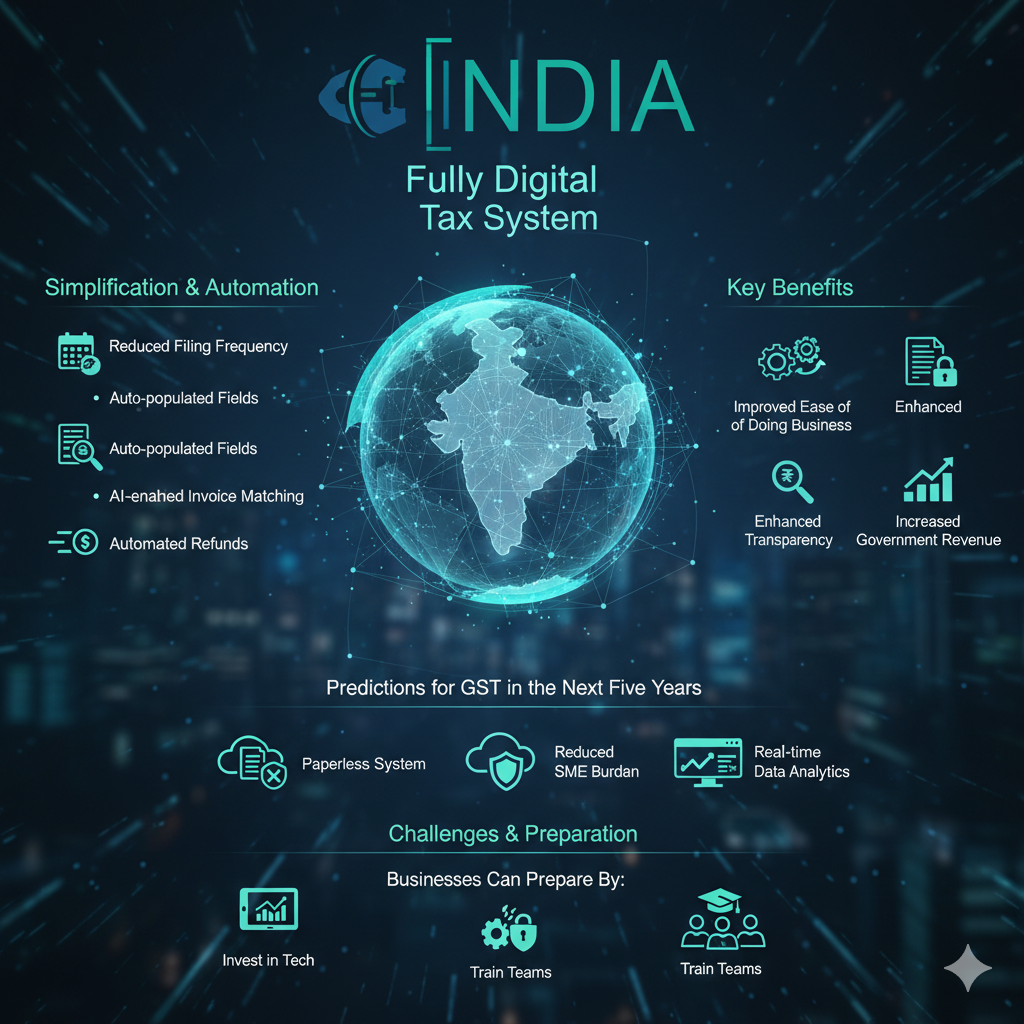1. Simplification of GST Returns
The GST Council is working on introducing a *single simplified return system*. This would:
* Reduce filing frequency.
* Allow auto-populated fields to minimise errors.
* Integrate e-invoicing and GST returns seamlessly.
2. Greater Automation in GST Compliance
Automation will play a major role in the future of GST:
AI-enabled invoice matching for ITC claims.
Automated return filing from accounting software.
Real-time compliance monitoring.
3. Faster GST Refunds
Efforts are being made to reduce refund processing time:
* Faster approval workflows.
* Pre-filled refund forms based on ITC data.
* Real-time status updates for taxpayers.
4. Expansion of GST E-Way Bill System
The E-Way Bill system will expand to:
Include more categories of goods.
Improve mobile app usability.
Introduce distance-based validity for faster transport compliance.
5. Rate Rationalisation
The GST Council is likely to focus on further rationalising GST rates:
Reduce rates for essential goods and services.
Simplify HSN code structures.
Align rates to support Make-in-India and export competitiveness.
Predictions for GST in the Next Five Years
Prediction 1 – GST as a Fully Digital Tax System
India’s GST is likely to move towards a *fully automated, AI-driven compliance system* where return filing, invoice matching, and refund processing are seamless and paperless.
Prediction 2 – Reduced Compliance Burden for Small Businesses
Quarterly filing, simplified returns, and threshold-based exemptions will make GST easier for SMEs.
Prediction 3 – Enhanced Transparency and Data Analytics
Real-time analytics and AI monitoring will enable better compliance tracking and reduce tax evasion.
Prediction 4 – Greater Integration with Financial Systems
GST will integrate more deeply with banking and accounting platforms to allow instant reconciliation and payment settlement.
Prediction 5 – GST Rate Harmonisation
Further simplification of rates will enhance transparency and reduce disputes between taxpayers and authorities.
Benefits of Future GST Developments
Improved Ease of Doing Business* – Fewer returns, simpler filings, and automated compliance will reduce business burdens.
Better Compliance* – Automation and AI will detect errors early, improving accuracy.
Increased Government Revenue – Better compliance and fewer exemptions will increase tax collections.
Enhanced Competitiveness – Lower compliance costs will help businesses compete globally.
Transparency – Real-time tracking will build trust between taxpayers and the government.
Challenges in the Future of GST
While future trends look promising, challenges remain:
Technological Barriers* – Small businesses in rural areas may struggle with automation.
Data Privacy Concerns* – Increased data collection must be safeguarded.
Resistance to Change* – Businesses and tax professionals need time to adapt.
Training Needs* – Widespread education is required for smooth adoption of new systems.
Expert Opinions on the Future of GST
Economists believe automation and simplification will make GST a global benchmark for indirect tax systems.
Business Leaders expect GST to reduce compliance costs and improve competitiveness.
Tax Experts stress that consistent policy changes and awareness programs are essential for smooth implementation.
How Businesses Can Prepare for Future GST Changes
Invest in GST-Compliant Technology* – Automate filing and compliance to adapt quickly.
Train Teams* – Ensure staff are updated on GST reforms and technology tools.
Maintain Accurate Records* – Data accuracy will be essential for automated GST compliance.
Monitor GST Council Announcements* – Stay ahead of regulatory changes.
Engage Tax Professionals* – For strategic planning and risk management.
Conclusion
The future of GST in India looks promising with reforms aimed at simplification, automation, and transparency. By 2025 and beyond, GST is likely to evolve into a fully digital, business-friendly tax system that supports economic growth while reducing compliance burdens.
For businesses, the key to thriving under future GST regimes will be adaptability. Embracing technology, staying informed about reforms, and ensuring accurate compliance will make GST a strategic advantage rather than a regulatory challenge.
GST is not just a tax reform — it’s shaping the future of India’s economy, trade, and business environment.
### FAQs – Future of GST
*Q1. Will GST become simpler in the future?*
Yes, reforms are focusing on simplified returns, automated compliance, and fewer filing requirements.
*Q2. How will automation change GST compliance?*
Automation will streamline filing, improve accuracy, and reduce manual errors.
*Q3. Will GST rates change in the future?*
The GST Council is expected to rationalise rates for transparency and ease of compliance.
*Q4. How can businesses prepare for GST changes?*
By investing in GST-compliant technology, training staff, and maintaining accurate records.
*Q5. What is the biggest challenge for the future of GST?*
Ensuring technological adoption and training for all businesses, especially SMEs and rural enterprises.


